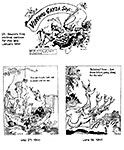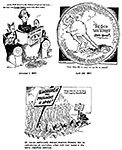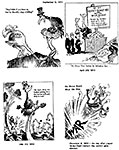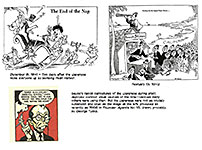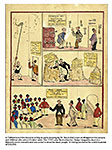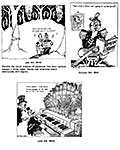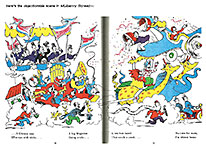 |
||||||||||
Opus 371 (October 17, 2017). We did it again: we ran off at the mouth to great length, longer than anyone could be expected to wade through. So, ever solicitous of our faithful readers’ well being, we cut it all in half, and jammed into this posting all the most topical stuff, the news— Hugh Hefner’s death, Schulz home burns but Museum is okay, Rocky Mountain Comic Con, Pepe fighting back, The New Yorker’s “what if” cover, editoons of the turbulent month, and a long segment sparked by the 113th annivesary of Dr. Seuss’s birth, including his anti-America First stance in WWII political cartoons, the new Seuss Museum and the accompanying controversy from Right Thinkers. Next time—within days, kimo sabe—we’ll do a passel of reviews, just to keep you thoroughly up-to-date. Meanwhile, here’s what’s here, in order, by department—:
NOUS R US Schulz Home Burns, Museum Okay Hugh Hefner Dead at 91 New Home for San Francisco Cartoon Art Museum Sean Spicer at the Emmys
REPORT ON THE ROCKY MOUNTAIN COMIC CON
The New Yorker’s “What If” Cover Pepe Fights Back Malaysia Bans Another Zunar Book Zunar’s Statement Another Cartoonist Behind Bars Overseas
Odds & Addena Superman Fights Dr. Manhattan Archies No.1 Tribune Tower Dethroned American Barbarella
EDITOONERY The Latest Antics My Rant on Gun Laws
Happy Birthday Dr. Seuss A Poem Seuss the Political Cartoonist & America Firsters Seuss Museum Opens —Amid Right Thinking Controversy
QUOTE OF THE MONTH If Not of A Lifetime “Goddamn it, you’ve got to be kind.”—Kurt Vonnegut
Our Motto: It takes all kinds. Live and let live. Wear glasses if you need ’em. But it’s hard to live by this axiom in the Age of Tea Baggers, so we’ve added another motto:. Seven days without comics makes one weak. (You can’t have too many mottos.)
And our customary reminder: when you get to the $ubscriber/Associate Section (perusal of which is restricted to paid subscribers), don’t forget to activate the “Bathroom Button” by clicking on the “print friendly version” so you can print off a copy of just this installment for reading later, at your leisure while enthroned. Without further adieu, then, here we go—:
NOUS R US Some of All the News That Gives Us Fits
PEANUTS MUSEUM ESCAPES WILDFIRE But Charles Schulz Home Is Burned To the Ground Santa Rosa was hit by some of the wildfires spreading through northern California, but its famed Charles M. Schulz Museum and Research Center was spared. The Museum closed, however, due to lack of power caused by the fires. “We do not know at this time [October 11] when we will reopen,” said Tracey Pugh, the marketing director. “We will be updating our social media and website with this information as we have it.” Unhappily, the home of Peanuts creator Schulz burned to the ground. His widow, however, escaped, her stepson told the Associated Press. Jean Schulz, 78, fled her home at about 2 a.m. Monday, October 9, and is now staying with family, said Monte Schulz. "It's the house my dad died in,” he went on, “—all of their memorabilia and everything is all gone. Stuff from my dad and their life together, all gone. That time of our lives is now completely erased. “She is very resilient,” he about his stepmother. “She is energetic and pragmatic and very tough.” His father had long-standing ties to Santa Rosa and to Sonoma County. He and his first wife, Joyce, built a home in the city of Sebastopol in 1958. The airport in Santa Rosa Airport is officially titled the Charles M. Schulz - Sonoma County Airport and features bronze sculptures of the Peanuts characters. Its logo is Snoopy flying on top of his doghouse.
HEFNER DIED. IN HIS BED, OF COURSE Hugh Hefner
died on Wednesday, September 27. He was 91. Celebrated as the founder of Playboy magazine, which, with fold-out photos of barenekkidwimmin, revved a cultural
revolution that freed the sex lives of Americans from their Puritan bondage,
Hefner was a wannabe cartoonist whose magazine showcased and advanced the art
of the single-panel magazine cartoon, publishing full-page cartoons in sumptuous
color. His departure from this vale of tears was, gratifyingly, heralded by
many cartoonists (albeit of the political ilk), once potential colleagues. Although Hef (as he was known) appeared in a dapper suit when hosting his Playboy tv series, he was most often photographed wearing a silk robe and pajamas, which everyone supposed meant that he was taking a brief respite from canoodling with one (or more) of the several voluptuous women he kept on hand at the ready in the Playboy Mansion, enjoying an enviable if adolescent life style. But the real reason he was in his pj’s was that he was so eager to get to work in the morning when he arose that he didn’t bother to get dressed. Hef was a workaholic, and he often didn’t go to bed at all. If he could stay awake for 24 hours to edit his magazine, he would. Sometimes, fueled by dexedrine and Pepsi Colas, he made it to 40 hours straight. In other words, the nation’s foremost exemplar of a life of “play” actually worked all the time and seldom “played.” Before
he thought of publishing a magazine, Hefner aimed to be a cartoonist. He drew
cartoons in high school and in college at the University of Illinois, where he
also edited an issue of the off-campus humor magazine, Shaft, espousing
the liberating ideas about sex upon which Playboy was founded. All
through his youth, he drew an autobiographical comic book, and after college,
he published a book of his cartoons about life in Chicago, That Toddlin’
Town. Hefner wanted cartoons to be a major component in Playboy, saying: “I once commented that without the centerfold, Playboy would be just another literary magazine. The same can be said for the cartoons. Playboy’s visual humor has helped to define the magazine.” He was a keen student of the cartoon medium and therefore a superlative editor of them. Cartoonists published in Playboy all spoke of the excellence of his insightful editorial guidance. In 2016, Hef, still active in editing the magazine he founded, and his editors, hoping to compete with a growing number of laddie magazines and realizing that the Web offered more pictures of naked ladies than Playboy could ever hope to cram into its pages, eliminated unabashed female nudity from the magazine. (See Opus 349 for details.) That didn’t last long: within a year, naked wimmin were back, sashaying through the magazine’s pages in unadorned splendor as of yore. The new regime that published pictures of artfully draped rather than naked ladies also decided Playboy no longer needed cartoons and stopped publishing them. Alas, cartoons did not return to Playboy with the nudes. With his magazine no longer publishing cartoons, we could say, with some poetic justice, that Hefner’s life had lost its original meaning. And so he stopped living. At
the notice of Hef’s death, the supermarket’s most energetic tabloid, the National
Enquirer, leaped forward with a bushel of scandalous factoids about him and
his supposed last days. “In life,” asserted the newspaper, “Hugh Hefner knew a
million lovers and rarely—if ever—slept alone. In death, he was a bankrupt and
wrinkled recluse, withered to a skeletal 90 pounds, and cut off from even those
he most loved.” The Enquirer claimed inside knowledge about “the tortured final days of America’s most legendary Lothario. The end, by any account, “was nothing like the life Hef lived” according to “a Hollywood insider. “He lived in shocking, urine-soaked squalor. He had to be lifted into and out of a wheelchair. Hef was desperate to hide his true condition. He wanted so badly to have his memory preserved as the swashbuckling playboy he was in youth... the virile stud with millions of hot girlfriends. “The truth is he became a modern-day Howard Hughes—alone, refusing to see guests, his fingernails overgrown, his breath a putrid stench, the air around him suffocating and musty.” The official cause of death was cardiac arrest. But the Enquirer reported that he was “cancer ravaged.” In short, the Enquirer was having the time of its life making up stuff about the man the tabloid doubtless idolized for a satyric lifestyle that might’ve crammed the paper with juicy copy for years. But didn’t. In our next Hindsight, we’ll do a lengthy biography of the man and his adventures with the magazine he invented. We’ll shoot for something less sensational than the Enquirer’s raison d’etre, something approaching verifiable fact. In the meantime, you could visit Harv’s Hindsight for September 2008, wherein we examine Hef’s life with cartoons in the college magazine he briefly edited and in the early years of Playboy.
THE MUSE HAS A NEW HOME The Cartoon Art Museum of San Francisco, which lost its lease a couple years ago, has a new home. It’s signed a 10-year lease in a historic building at 781 Beach Street overlooking San Francisco Bay, a short walk from Fisherman’s Wharf. A block or so in one direction is Ghirardelli Square; about the same distance in the other direction—at the corner of Beach and Hyde streets, where the Powell Street cable car turnaround is situated—is the BeeVee, the Buena Vista, where, according to vintage rumor, Irish coffee was invented and is still being purveyed. One of the things I never miss doing when in town is taking the cable car up Powell and Hyde to the BV, where I always have a few Irish coffees. More than I should. The new digs boasts a state-of-the-art gallery with movable walls, a screening area, classrooms, an education center and library, storage facilities for its permanent collection of 7,000 original pieces of art, and the Museum bookstore with storefront visibility and interior access from the museum lobby as well as offices for the Museum’s staff. Founded in 1984, the Museum is now the oldest cartoon museum in the country. Having raised $950,000 of the $1,100,000 needed for its new home, the Museum re-opened a few weeks ago; the fund-raising campaign is now open to the public. For more about how to donate, visit the Museum website, cartoonart.org. In case you’re wondering why I’m devoting all this energy and visibility to this facility and this campaign, you should know that I’m on the Advisory Board. But they don’t pay me, and my personal fortune is not at all affected by the fund-raising.
Comedy at the Emmys THE BEST PART, indubitably, of the Emmy show in mid-September was the surprise appearance of former Trumpet press secretary Sean Spicer. Emcee Stephen Colbert took a moment towards the beginning of the show to wonder aloud just how large the Emmy audience was. “Can anyone tell how large it is?” he wondered. In answer to his ponder, here came Spicer, wheeling a podium in front of him, a jovial mimic of Melissa McCarthy’s “Saturday Nigh Live” mockery of Spicer. Spicer then answered Colbert’s question: “This will be the largest audience to witness an Emmys—period,” he shouted with undeniably authority. “Both in person and around the world,” he finished, echoing his claim that the Trumpet’s inauguration crowd was the biggest ever. I thought it was great. Spicer participating in—perpetrating!—a joke about himself But almost at once, some Sensitive Souls voiced disapproval. Giving Spicer a moment at the Emmy show was effectively giving approval to the lying he customarily did from that podium when he was the Trumpet’s press secretary. He lied at the behest of his boss, but whether his lies were presidential or not, he lied nevertheless. Well, phooey. Anyone who appreciates comedy—anyone but the Sensitive PC Souls wringing their sensitive hands—had to love the moment. Spicer proved he can laugh at himself—something no Sensitive Soul can do. And Spicer’s satirical treatment of himself confirms that he knew he was lying at the time he lied about the Trump inaugural audience. And probably about a lot of other things, too. But I still admire his self-deprecating sense of humor. Sensitive Souls should try it sometime.
ROCKY MOUNTAIN CON The crowd was thin at the Rocky Mountain Comic Con, held at the Crowne Plaza near the Denver airport September 29 - October 1. Denver now can boast of three so-called “comic conventions”: the Denver Comic Con, usually held in June, DINK (Denver Independent Comic and Art Expo, celebrating independent and alt comics and art culture) in April, and the Rocky Mountain Con in the fall. The RMC bills itself as being about comics, gaming, anime, toys and sf. Perhaps attendance was light because it casts too large a net, and no one knows what it’s really about. But I doubt it: the other two cons aim in about the same direction. Vendors looking up and down mostly empty aisles, however, think the RMC didn’t advertise enough, depending upon its website rather than promoting through local print media. Artists Alley was essentially a craft show; and toys were the chief manifestation in the booths. At least three local comic book stores were on hand, but comics weren’t the attraction. Action figures were. My table was the first table inside the entrance—books about cartooning and a standing offer to caricature interested parties. But there appeared to be no parties interested in cartooning: most attendees walked by my table without giving it a glance. They were looking for something other than comics.
Jim Steranko was the Big Name guest. Other guests included cast members of the new Star Trek, none of whom is familiar to me, so I went over to talk with Steranko. On Saturday, a line of admirers formed at his table; on Sunday, almost no one was there. Thinking on Sunday that I’d not be denying a devotee a moment with his idol, I walked up and introduced myself. He greeted me as if we were long-lost cellmates even though we’ve never worked together or, even, met. He may have been remembering (though I doubt it) a spoof I did decades ago about a feature he was running in his magazine, Mediascene. I’ve posted the spoof near here. Somehow, I’d learned his address and sent him a copy of my lampoon. He responded with a note and a simple declaration: “I prefer my girls shaved.”
At his table at the Con, I asked him what he was doing these days, and he showed me several covers he’d done for Marvel. And he dabbles in tv and movies, just as he always has —helping to crank up layouts for publicity and the like. I’d started us off by saying that he was a year younger than me (which is true: he was born in 1938), so some of our conversation was about aging. He said he feels 25. His personal and professional life is packed, he said. He has only one physical complaint: in his youth, he’d been quite a gymnast, and he’d damaged the rotator cuff of one shoulder while working out on the rings. I said my doctor had told me my shoulder pain was likely a damaged rotator cuff—and did I want surgery? No, I said. But then, I told Steranko, the pain eventually went away. “Cured itself?” he exclaimed. “Right,” I said. “I want a blood transfusion,” he said, grabbing my arm.
I HAD A GOOD TIME at RMC. Didn’t sell much, but on Sunday I talked with several aficionadoes. Bob Hall was there. His I, Joker, which he wrote and drew, is a masterpiece of a comic book; I reviewed it in May 1999, in Opus Two (and if you venture back there, you’ll see why I call it a masterpiece). We talked about what he was currently doing. He’d spent 15 years honchoing a Shakespeare festival in Lincoln, Nebraska at the U. of Nebraska, and he described his present occupation as “looking for work.” Which is the same as saying that he’s working as a commercial artist. I
met Andy Broome from Dallas, who had chanced by accident upon the RMC.
He’d come to Denver for a gaming convention being held at the same time in the
same hotel. He was on his way to Leadville, Colorado, where he was going to
interview Ted Mullings, a cartoonist who for 40 years had done a cartoon
feature for the Climax mining corporation. I’d never heard of Mullings, but I’m
now looking forward to seeing
One of the most memorable events of the Con, however, took place at the table right behind mine in Artists Alley. There a nine-year-old boy named Bruce was drawing pictures of assorted monsters and heroes of his own devising and selling them. Judging from the sample posted hereabouts (for which I paid $15), he’s on his way to being a comic book artist. I had to ask him to sign it; he hasn’t yet outgrown juvenile anonymity even if he has acquired an entrepreneurial sense of values.
THE NEW YORKER’S “WHAT IF” COVER The image at
the left on the accompanying visual aid is the cover that The New Yorker planned
to run if Hillary Clinton had won the 2016 election. On the right is the
cover the magazine actually ran, a somewhat (no—roaringly) ambiguous statement. The image, Michael Cavna tells us, is by French artist Malika Favre and is titled “The First.” It depicts a historic President Hillary Clinton gazing at the moonlight from the would-be viewpoint of the Oval Office. Running with Remnick’s article, the image takes on an entirely different tone — “not of history, but of the poignancy of the hypothetical,” Cavna observes. “That image brings everything back to me in a flash,” New Yorker art editor Françoise Mouly told Cavna at the Washington Post’s Comic Riffs. “The night of the election, I was at the office late, hard at work with final retouching on [Favre’s] image. I was focused on the technical details, getting the face just right, and on the layout. … “I was trying not to tune in the results coming in. I had not prepared anything else [for the post-Election issue],” continues Mouly, who last winter launched the Resist! cartoon newspaper in response to President Trump’s victory (see Opus 361). “The sense of dread that crept among the few colleagues still in the office eventually overwhelmed me, and I left.” Favre’s experience on that historic day was somewhat different: “I remember going to bed with a feeling of relief, pride and excitement and waking up the next day to intense disappointment. It was frustrating on all counts.” The artist notes that the artwork can be read on multiple levels. “There is that moment of glory of seeing her standing in the Oval Office at night,” the artist says of the Clinton figure, “but also that feeling of anticipation and almost loneliness that I wanted to convey. A little bit like a ‘What now…?’ moment.” Mouly salutes the lasting power of Favre’s image, even when cast in a different historic light. “The pent-up hope, the sense of accomplishment, the turn toward the future that we embraced up to that day is still in the image. It’s a testimony to the skill of a great artist that she can bring us back to that time of hope,” says Mouly, who has spoken often about her opposition of Trump. “And with her permanent record of that feeling, we’ll find the strength to build a future we can believe in.”
PEPE FIGHTS BACK The creator of Pepe the Frog is making good on his threat to aggressively claim his intellectual property. Matt Furie’s lawyers have taken legal action against the alt-right, reports Matthew Gault at motherboard.vice.com, serving cease and desist orders to several alt-right personalities and websites including Richard Spencer, Mike Cernovich, and the r/the_Donald subreddit. In addition, they have issued Digital Millennium Copyright Act takedown requests to Reddit and Amazon, notifying them that use of Pepe by the alt-right on their platforms is copyright infringement. Amazon, Reddit, Twitter, Google, YouTube, Mike Cernovich, Baked Alaska, and Richard Spencer did not immediately respond to Gault’s request for comment, but he says the large entities like Amazon and Google have been the most compliant so far. Stamping out the multiple vendors peddling Pepe merchandise on Amazon will be difficult, but Furie’s legal team, working pro bono, has already succeeded in removing several shirts from the market, including the one worn by Morris May when he pepper-sprayed a transgender activist in early September. Several entities that have received notices from the Furie phalanx have said they’ll fight back. But the message to the alt-right is clear—stop using Pepe the Frog or prepare for legal consequences. To that end, one of Furie’s intellectual property lawyers, Louis Tompros, and his team have taken the first steps towards dismantling the alt-right's stranglehold on Pepe, beginning with their letter to Richard Spencer's Altright.com, noting the specific places where Spencer and his team have used Pepe in violation of Furie's copyright. Pepe is all over Spencer's site and is the mascot for his podcast, Alt-Right Politics. "We've asked them to take them down," Tompros said. "That hasn't happened yet, but they're very much on notice. We plan to take action if they don't. If necessary, we expect to bring a lawsuit for copyright infringement," Tompros went on. "I want to make sure that people have enough time to comply. The goal here is not to initiate lawsuits. The goal is to get the misuse of Pepe to stop. I'd rather do that through people complying with the cease and desist notices. But we're certainly ready, willing, and able to bring suits to follow up for the folks who do not comply." Furie originally created Pepe as a non-political character for his Boy's Club comic, but Pepe later became an internet meme, and during the 2016 presidential election, the alt-right movement appropriated the frog in various grotesque and hateful memes. At the end of August, Furie's lawyers reached a settlement with Eric Hauser—the former assistant principal in Texas who appropriated Pepe's image for use in an Islamophobic children's book. As reported at Opus 370b, Furie's lawyers forced Hauser to stop selling the book and made him donate his profits to the Council on American-Islamic Relations. When Hauser agreed to settle out of court, Gault spoke with Furie's lawyers who told him they would use the Hauser settlement as a springboard to go after anyone else who profited from or misused Pepe. “It appears they've made good on that promise,” said Gault. In the past, the alt-right has attacked its enemies with vicious doxing and online abuse campaigns. Tompros and his team understand that's a risk, but it's one they're willing to take. "We're doing what we think is the right thing," he said. "We understand that we're dealing with serious folks here, and we want to make clear to them that we're serious too. We're not going to stand for this." Furie has continued to avoid speaking with the media about Pepe, but Tompros told Gault that the win against Hauser lifted his spirits. "That's been powerful for him," the lawyer said. "He's ready and wants to keep up the fight and wants to take down anyone who's using his character. He's also received words of support from fans and others. He's taking comfort in that. We're going to keep on fighting," Tompros said. "I hope we're doing what others would do when it's there to turn to stand up for the good guys."
Malaysia Bans Another Zunar Book, Ignoring UN Reprimand By Maren Williams at cbldf.org Zunar, the Malaysian cartoonist charged with nine counts of sedition which could net him up to 43 years in prison, got some much-needed international support last month when a United Nations envoy for cultural rights expressed “deep concern” about the case. On October 3, however, the Malaysian government once again thumbed its nose at free expression and banned Zunar’s 2015 book Sapuman: Man of Steal. This
latest ban marks the ninth Zunar book condemned by Malaysian authorities. The
titular “man of steal” is none other than Prime Minister Najib Razak, who
allegedly diverted $700 million from a government investment fund into his
personal bank account in what came to be known as the 1MDB scandal. (Sapu is a Malay word meaning to grab or snatch.) Zunar defiantly continues to offer
the book for sale on his website, along with Conspiracy to Imprison Anwar which is also officially banned. Zunar is scheduled to face trial soon on the nine sedition charges which stem from statements that he made on Twitter in February 2015 following the sentencing of opposition leader Anwar Ibrahim on a trumped-up sodomy charge. The cartoonist hinted that the judiciary in that trial had been subject to political pressure or bribery, observing that “the lackeys in black robes are proud of their sentences. The reward from political masters must be plenty.” He then exchanged Twitter barbs — and a cartoon — with Inspector-General of Police Khalid Abu Bakar as officers were en route to arrest him. Last month UN Special Rapporteur on cultural rights Karima Bennoune made a 10-day visit to Malaysia in order to “assess efforts to implement the right of all people to participate in cultural life,” according to a press release. In a preliminary report following her visit, Bennoune called for the repeal of the country’s Sedition Act—a legacy of its British colonial past—and for all charges against Zunar to be dropped. She added that she and other UN experts would be closely following the cartoonist’s trial, which has been delayed multiple times since 2015. Meanwhile, Zunar also was given a court date of October 13 for his challenge to a travel ban imposed on him last year. Although the cartoonist had repeatedly rejected the very idea of abandoning the country in order to escape prosecution, Abu Bakar personally ordered last year that he be barred from international travel until the sedition case is resolved. In 2015, Zunar told Vice News that “I want to expose this for my country, not for me alone, and the government will get an official trial. This is my responsibility.” In response to the Sapuman ban, Zunar posted a statement on his website that suggests he’s as undaunted as ever (see below). He added that he plans to file yet another legal challenge to the latest ban. In 2015, he successfully fought a ban on two other books all the way to Malaysia’s top court.
Zunar’s Statement By Zunar The government of Malaysia has announced the banning of my cartoon book, Sapuman: Man of Steal under the Printing and Presses Act as per press report October 3, 2017. Previously, my other books – Gedung Kartun, 1 Funny Malaysia, Isu Dalam Kartun (Vols. 1, 2, 3), Conspiracy to Imprison Anwar, Perak Darul Kartun and Pirates of Carry-BN – were also banned. Meanwhile Ros in Kangkongland and other titles are investigated under the Sedition Act. This is just one of the long list of harassment and intimidation by the BN government. Since 2009, my office in Kuala Lumpur has been raided a few times and thousands of my cartoon books have been confiscated. The printers, vendors, and bookstores around the country that carried my cartoon works were also raided. I was arrested several times and now facing nine charges under The Sedition Act. The government also banned me from traveling abroad since June 2016. I don’t make fantasy cartoons. My cartoons are results from my reaction on current issues, especially on corruption. For instance, the cover of Sapuman is about 1MDB Scandal which involves billions of Ringgit. If there was no IMDB scandal, I would not produce this particular cartoon. Do not blame the cartoonist if politicians steal billions. The ban comes a month after Prime Minister Najib’s meeting with President Trump in Washington. Surely the Prime Minister has picked up some lesson. If Trump has Islam-O-Phobia, Najib has Cartoon-O-Phobia! Let’s make it clear— if the government does not like my cartoons (I do not expect they will), I have no problem with it. But you cannot translate your interpretation into law by banning a book of my thoughts. This is against the Federal Constitution which guarantees freedom of expression. I have discussed with my lawyers and will file the legal challenge soon. I would like to reiterate that this ban will not stop me from drawing cartoons to expose corruption and injustice. You can ban my books, you can ban my cartoons, but you cannot ban my mind. When the government is faulty, drawing cartoons is a duty. All my books now only available online at www.zunar.my
ANOTHER CARTOONIST BEHIND BARS OVERSEAS Equatorial Guinean authorities arrested a political cartoonist and activist on September 16, 2017, according to Human Rights Watch and Equatorial Guinean Justice. He has been held in detention since then and authorities may be preparing to file criminal defamation charges against him. The Watch report follows—: The arrest of the cartoonist, Ramón Nsé Esono Ebalé, is the latest episode of government retaliation against artists who have used their work to criticize the government. Human Rights Watch urges EG authorities to repeal the country’s colonial-era defamation statute, which allows for the criminal prosecution of people who criticize the president and top government officials. They should abandon any plans to charge Ebalé under that law and, if he is accused of no other crime, release him immediately and without charge. “The Equatorial Guinea government has again demonstrated its hostility to any form of critical expression that escapes its heavy-handed censorship,” said Tutu Alicante, executive director of EG Justice, which monitors human rights violations in Equatorial Guinea. Three state security officers detained Ebalé outside a restaurant in the capital, Malabo, at about 7 p.m. on September 16, along with two Spanish nationals who were with him. All three men were taken to the Office Against Terrorism and Dangerous Activities in the Central Police Station. The Spanish nationals were interrogated about their connection to Ebalé and freed after several hours. Authorities continue to hold Ebalé without charge, exceeding the 72-hour period allowed under Equatoguinean law. Interrogators reportedly questioned him about his political cartoons, which often lewdly caricature President Teodoro Obiang Nguema Mbasogo and other government officials, and repeatedly told him that people may only participate in politics if they are associated with an official party. Ebalé has lived outside of Equatorial Guinea for several years and had returned to the country to renew his passport. He has not been taken before a judge, which Equatoguinean law requires within 24 hours. Family members were allowed to see him on September 18 and 19, though prison guards refused to allow his sisters to visit on September 17 or to confirm he was being held there. Based on the interrogators’ apparent questions, EG Justice and Human Rights Watch are concerned that Ebalé may be charged with violating Equatorial Guinea’s criminal defamation statute. In Human Rights Watch’s view, such laws are incompatible with the right to free expression and Equatorial Guinea’s statute should be repealed. The arts have traditionally served as a safe space for independent voices to provoke public debate on social issues in Equatorial Guinea, a country with little tolerance for political dissent. But EG Justice and Human Rights Watch have documented an increasing number of incidents over the past two years in which the government has retaliated against artists and cultural groups. “Prosecuting a cartoonist for unflattering satirical drawings is incompatible with free speech and only highlights the power of the pen,” said Sarah Saadoun, researcher at Human Rights Watch. For reports of other cartoonists internationally who have been threatened and/or jailed, see Comic Book Legal Defense Fund’s website, cbldf.org
ODDS & ADDENDA Superman will battle Dr. Manhattan in the forthcoming (and much denigrated) Doomsday Clock, the 12-issue series that tries to capitalize on Alan Moore’s inspired creation, the Watchmen, by bringing them back again. Few think this will work as well as the original; and I agree. Due in shops November 22 with a 40-page, $4.99 No.1. ... And the inaugural issue of The Archies arrived October 4; in No.2 of the title, the Archies meet a real-life band, the Chvrches, who will guest star in No.3. ... The famed Tribune Tower in Chicago, which, viewed from above, resembles a throne (upon which the Chicago Trib publisher Colonel Robert McCormick can be imagined as sitting) has been sold and will soon be converted to other uses. Dynamite Entertainment has announced the series artist for its upcoming Barbarella comic series, reports ICv2. Launching in December, Barbarella will be written by Mike Carey and drawn by Kenan Yarar (Hilal). Issue No.1 will feature eight different covers, including ones by Kenneth Rochafort, Joe Jusko, Joseph Michael Linsner, Robert Hack, and Annie Wu. In Vanity Fair’s New Establishment ranking for 2017, the only comics-related name is that of Kevin Feige of Marvel Studios, who ranks 21st, ahead of Walmart’s Marc Lore (who is 34th) and Dwayne Johnson (37th) but behind Alec Baldwin and Kate McKinnon, Saturday Night Live’s political impersonators (19th) and Jeff Bezos, who’s first in the list of 100 innovators, media-age moguls, technologists and rebellious entrepreneurs.
Fascinating Footnit. Much of the news retailed in the foregoing segment is culled from articles indexed at https://www.facebook.com/comicsresearchbibliography/, and eventually compiled into the Comics Research Bibliography, by Michael Rhode, which covers comic books, comic strips, animation, caricature, cartoons, bandes dessinees and related topics. It also provides links to numerous other sites that delve deeply into cartooning topics. For even more comics news, consult these four other sites: Mark Evanier’s povonline.com, Alan Gardner’s DailyCartoonist.com, Tom Spurgeon’s comicsreporter.com, and Michael Cavna at voices.washingtonpost.com/comic-riffs . For delving into the history of our beloved medium, you can’t go wrong by visiting Allan Holtz’s strippersguide.blogspot.com, where Allan regularly posts rare findings from his forays into the vast reaches of newspaper microfilm files hither and yon.
Further Ado From old timey cartoonist Oliver Herford: "A woman's mind is cleaner than a man's: she changes it more often.” A little sexism for the sake of pure nostalgia.
EDITOONERY The Mock in Democracy
“The political cartoon is not a news story and not an oil portrait. It’s essentially a means of poking fun, for puncturing pomposity. Cartoons ... serve the [same] purpose of helping readers understand situations. In opposing corruption, suppression of rights and abuse of government office, the political cartoon has always served as a special prod—a reminder to public servants that they ARE public servants.”—Herbert Block , 1977
AT FIRST, the Trumpet was garish and clownish, but he’s become borish—and dangerous. Taunting North Korea’s Kim risks outright global warfare. Withdrawing from the Paris accord and the Iran deal loses historic friends and allies in Europe and elsewhere. In this country, canceling Bronco Bama’s environmental orders pollutes air and water and risks the health and well being of our children, many of whom are now all likely to die of lung or liver diseases. In
this department of Rancid Raves we consider the Trumpet in his various guises,
but that is incidental to our guiding purpose, which is to showcase the editorial
cartoon, highlighting the ways it works to achieve its ends. Next around the clock, Dave Horsey conjures up a similar tidy bundle of imagery, critical of the Evangelical part of the base, who the cartoonist shows as worshiping a golden calf Trumpet, a devotion that distorts their thinking to such an extent that they see Moses’ commandments (“The Truth shall make you free” and “Beware of false prophets”) as “fake news.” A complex congeries of meanings that Horsey deftly knits into one image with interlocking parts. At the lower right, Glenn McCoy, usually a conservative voice so high-pitched I can’t hear him, provides an image of the Trumpet “draining” the swamp in Washington—which he’s doing in a particularly reckless way, springboarding off a supposed agreement with the Democrats to extend the debt ceiling for three months, putting debate on the issue smack before Christmas, where the Republicons’ holding up the extension will be most difficult politically. The picture of Trump “emptying” Washington of “the swamp” is delicious, depicting him throwing his weight around in the manner of a fun-loving adolescent. And then Randall Enos reminds us of how much the Trumpet’s junkets to golf courses in various parts of the country is costing us in accommodations at the remote sites for secret service agents and airplane fuel, among other costs. The
next cluster of editoons deals with the most recent national catastrophe, the
massacre in Las Vegas. By other measures, the number leaps from 355 in a single year to 317 over 15 years; yet another metric produces only 78 shootings between 1983 and 2012. However we count them, there are too many. No one disagrees with that. Next around the clock, Jeff Koterba offers a more poignant reaction: “one day in the future?” he hopes, the flag will be flying from the top of the pole. David Fitzsimmons itemizes “the steps” we take, one at a time, after every massacre. It’s a ritual, and it always ends with the Grandstanding Obstructionist Pachyderm doing nothing—except frustrating any legislative action except those that loosen the existing gun controls. And Steve Breen shows us why: Congress is an ostrich, ignoring gun violence by sticking its head right into the mess (symbolic, no doubt, of its intimate relationship with the National Rambo Association). In
the ensuing debate about whether right after a massacre is a good time to
discuss gun laws, the usual NRA rationales for having unlimited and absolutely
unfettered access to guns were trotted out. Jeff Danziger presents another of the NRA bogie-man arguments for having guns, showing a couple of crazies wanting to buy guns to defend themselves against the federal government attacking them. Really? And those guns they want to buy—even if they can be bumped into firing like a machine gun—are going to protect them against an invasion by tanks and jet aircraft? Crazy is right. And Danziger has succeeded in portraying the duo as just a little silly-looking. Another of the NRA positions is that ordinary citizens—not the crazy kind—need to have guns hanging around so they can act in self-defense against intruders or muggers or other bad hombres. To promote this idea, the NRA driver of the vehicle at the lower right in Clay Bennett’s cartoon displays his fear as a series of window-stickers representing himself, his wife, and their three children—all of whom have targets for heads. From the evidence of this cartoon, I assume Bennett is in favor of ordinary citizens having weapons to defend themselves; and I’m not sure but what he’s actually against unlimited gun access and widespread gun ownership. Clever cartoon, but I think it misfires—unless I’ve represented Bennett’s supposed position accurately. Signe Wilkinson’s metaphorical comment at the lower left is the final word on this visual aid—a memorable image dramatizing the nation’s “addiction” to fire arms. On
the next visual aid, Ann Telnaes has seized upon the Las Vegas disaster
to make points in the feminist cause. Amazingly enough, Congress did take a gun-related action in the days just after the Las Vegas shooting. They put on the back burner a bill that would make it easier to buy gun silencers, thinking, correctly no doubt, that passing such a bill in the wake of the slaughter in Las Vegas would be too much of an affront to American sensibility. But the bill will be revived once the excitement dies down; and it is expected to pass then. How many more people could the Las Vegas shooter have killed if none of his shots could be heard? It was the audible pop pop pop of his weapons that alerted the crowd—and the authorities— to the developing danger around them. But equipped with a silencer ... Greater gun control would obviously drive the GOP base insane. But, as one wag said, how would we know?
AND NOW, for
the elements and forces of nature. Tom Toles quipped that hurricane victims
were “at the mercy of the elements”; no, he elaborated, “of the
elephants”—invoking the traditional posture of the Republicon reluctance to
spend money. Meanwhile, the Trumpet distinguished himself in his reaction to
Hurricane Maria’s devastating Puerto Rico. Below that, Nick Anderson’s metaphor reveals the extent of the Trumpet’s heedlessness: the only meal on the Puerto Ricans’ tables that weekend was a festive blue fowl. All that the Trumpet was doing on this tragic occasion was tweeting. And Clay Jones at the lower left finishes the indictment of the Trumpet. When Trump finally made an inspection visit to Puerto Rico, he created a photo op for himself by throwing rolls of paper towels to the masses—as if a roll of paper towels would be of any real help to people without food, water, fuel or power. Well, I suppose they could use the towels to soak up the surplus water. On his visit, the Prez again ignored the devastation all around him to make a self-glorifying speech: “Now I hate to tell you, Puerto Rico,” he trumpeted, “but you’ve thrown our budget a little out of whack because we’ve spent a lot of money on Puerto Rico.” See? We’re not ignoring Puerto Rico’s plight: we’re spending a lot of money on Puerto Rico. And when San Juan’s mayor criticized him for the slowness of federal response, the twitterpated Trumpet jumped all over her for her display of ingratitude. What a guy. The Dallas Morning News observed that for Trump to criticize her from “the comfort of his luxury golf resort” while she was chest-deep in flood-water isn’t just bad optics; it “is chilling.” The
insensitivity and preoccupation with self-image that the Trumpet displayed
throughout the Puerto Rican episode (and Houston’s) (and Florida’s) is
enthusiastically attacked by Kevin “Kal” Kallaugher and Jack Ohman on
the next exhibit. Ohman takes aim at the same target, showing the Trumpet more concerned about his image than about making any real contribution to alleviate the distress of flood victims. To bend over backward here for a minute—not, admittedly, my usual Trumpian posture— the Trumpet was perhaps unfairly the target of much news media criticism for the way his administration reacted to Maria in Puerto Ricco. It was as if journalists nationwide were just waiting, impatiently, for him to stub his toe, for him to commit a faux pas on the scale of GeeDubya’s apparently unfeeling and ineffective reaction to Hurricane Katrina in 2005, so they could blast him for malfeasance. He escaped in Houston; and he escaped in Florida. In both cases, the federal response was good. But it somehow fell short in Puerto Ricco. How short? Trump claimed the apparent slowness of response to Maria was due to the site being in the middle of an ocean, implying that the logistics of support in such a case would make any response seem slow. But according to the Washington Post, Bronco Bama had 22,000 U.S. troops on the ground in Haiti, another island surrounded by ocean, within two weeks of the earthquake there in 2010; in Puerto Rico, eight days after Maria struck, just 4,400 service members were participating in aid efforts. But that wasn’t the whole story. The Richmond Times-Dispatch reported that federal and military aid was both “swift and large-scale”: within days FEMA had delivered 4 million meals, 6 million liters of water and other supplies to the San Juan airport. However, “pallets upon pallets” sat on the tarmac “because there are so few working buses and few traversable roads.” Consequently, in the hinterlands, people were desperate for water, food, fuel and medical help. But the Trumpet’s response to the slightest criticism made everything worse, revealing his thin skin and tone-deaf ignorance. Meeting with storm victims in Puerto Rico, saith The Week, “he repeatedly praised his administration’s ‘incredible response,’ telling Puerto Ricans they should be ‘very proud’ that thousands of people didn’t die in Maria’s wake as they did in ‘a real catastrophe like Hurricane Katrina.’” What? So Trump is responsible for fewer deaths in Puerto Rico than occurred in New Orleans’ Katrina? How does that add up? Or is it the Puerto Ricans through some mysterious alchemy that prevented Katrina–sized death tolls? Katrina, he assured them, was a “real” catastrophe, not a fake one like Puerto Rico’s. As always, the Trumpet reacted to criticism by attacking his critics. In another of his utterances in Puerto Rico, he said: “All things considered, everyone’s doing an incredible job—except for local officials who are expecting that everything be done for them.” The man is an enigmatic putz, a roaring asshole. However, the Trumpet was bested in egotistic heedlessness by the ever-cheerful Houston happiness televangelist, Joel Osteen, who refused to open the doors of his 16,800-seat house of worship (a former sports arena) to shelter those grubby Harvey victims with mud on their shoes, as Nick Anderson points out at the lower right of our last-posted visual aid. Osteen in Anderson’s metaphor is floating comfortably on a sea of money. Eventually, Osteen, shamed for his callousness, opened the facility. But at first, he more than matched the Trumpet for tone-deafness. Shifting the subject briefly, we come to Glenn McCoy’s image that analyzes, from the Republicon point of view, the effect of Trump and his Democrat cohorts, Nancy Pelosi and Charles Schumer, colluding to raise the debt ceiling for three months. Trump’s cooperation with the Dems was seen by many Republicons as a betrayal, and McCoy, constructing an ingenious metaphor, portrays it as suicidal.
TAX REFORM is
the next item on the Trumpet’s legislative agenda (which, we are repeatedly
reminded, has not resulted in a single major achievement). Kevin “Kal” Kallaugher produced a comic strip that compares the tax reform project to the health care reform project: the Trumpet was nearly clawed to death by the latter, which is a mere kitten compared to the tiger of tax reform. The multipanel format permits Kal to show a disastrous encounter between Trump and health care developing and then culminating, leaving Trump in a damaged condition to face the tiger. The Trumpet also made headlines in foreign relations during the last month. As John Cole shows us at the lower left, Trump’s speech to the United Nations was more bellicose than a U.S. president usually gives on such an occasion. In effect, Trump advocated for war, scarcely a customary posture before the U.N., which was created in the post-WWII hopes that such an international organization could avert war forever. And
the Trumpet’s belligerence was on display throughout the month. John Cole turns to Trump’s constant chorus extolling how much winning he’s doing. Failures at winning have been tossed into the waste basket, and the insert blank on Trump’s speech balloon reveals how handily disposable are his projects for winning. At the lower left, Phil Hands supplies the best over-all metaphor for the Trump as an international diplomat. Hands’ cartoon is ostensibly about Trump’s attitude towards the “embarrassing” Iran deal which reveals that he’s the embarrassment for America, a blundering clown. The same can be said for virtually everything he’s said or done on the international scene.
THE TRUMP’S
CRUSADE against football players’ using an aspect of their sport for political
protest has made more noise than the original protest did. He’s been successful
in creating a major disturbance where almost nothing existed before. If this is
winning, I’m a little dubious. The controversy, which was fading fast from national perception, has, in the usual fashion of scandalous events, misapprehended and misrepresented the issues. In the first place, Trump turned a protest about the national anthem into a protest about the flag. The anthem and the flag are not the same things. The anthem uses words, some of which black football players saw as ironic in the light of police violence against fellow black Americans—“the land of the free,” for instance. The flag, however, is a mute symbol. I don’t think the initial protests were against the flag: they were against the sentiment represented by the anthem’s words. Admittedly, the anthem itself celebrates the flag, so I suppose confusion is at least possible—and perhaps, in this instance, intentional. Regardless, most of us knew what the football payers were protesting. And the anthem/flag was merely symbolic of a culture that, they protested, did not exist for many of their fellow Americans. As for “taking a knee,” that’s what a football player does when he catches a kickoff and doesn’t want to run with it. When he drops to his knee, he signals “end of play.” What the protesters were saying, seems to me, was that they weren’t going to dance to the music of the national anthem because it sounded notes that seemed sour to them. Matt Bors takes us back to reality: we can’t imagine the Trumpet standing for the playing of the national anthem while lounging as he watches a football game in tv. (But none of us stand when watching tv, eh?) When many football players linked arms in sympathy with the spirit of the protest instead of actually kneeling, Signe Wilkinson found another use for the metaphor as we see at the lower right. She shows the Trumpet also linking arms with his fellow players. What the Trumpet caused by his injudicious labeling of football players as “sons of bitches” was a wholly unprecedented event in the annals of sport according to Dave Zirin, writing in The Nation: “Nothing in the history of sports and politics can compare with what happened on Sunday, September 24, when expressions of dissent broke out during the national anthem at every single NFL game. Some players knelt, some sat, some raised fists, and some linked arms. ... Two anthem singers—a black man in Detroit and a white woman in Nashville—took a knee during the last note of the song. ... All of them were joined in opposition to Donald Trump.” Sadly, in the face of such solid objection to the Trumpet, NFL officials (owners and the like) are reportedly considering making it mandatory for players to stand during the national anthem. What sniveling cowardice and appeasement. Before leaving the exhibit at hand, we turn to the Grandstanding Obstructionist Pachyderm attempting, one more time, to repeal and replace Obamacare. Nate Beeler’s visual metaphor at the lower left tells us all we know about that effort. In
the next visual aid, Tom Toles interprets the “block grants” of the
latest GOP health care travesty in a way that suggests how they will function:
it’s an old-fashioned chopping block, and the self-satisfied pachyderm will
chop off the life of the patient. In R.J. Matson’s visual metaphor of the GOP’s most recent (and last?) try at passing a cruelly abbreviated health care plan to take the place of Obamacare, Matson dramatizes the impossibility of its passage, and the caption is the frosting on the cake. Moving into other realms of Trumpian fantasy, Clay Bennett’s jigsaw puzzle image makes a stunning comment on the Trumpet’s slogan. The shape of the puzzle piece says it all. And then we have at the lower left Jim Morin’s take on Attorney General Jeff Sessions’ announcement of the latest Trump immigration policy, which is, as nearly as I can make out, to keep everyone out. Well, not everyone. Just those who aren’t white and don’t speak English. Sessions amuses me when he approaches a podium to make some sort of announcement. His chipmunk face has a small grin forming, and I wait for him to chuckle obscenely over what new affront he’s about to commit. Cute. But heartless.
IN OUR NEXT
EXHIBIT, another aspect of the Trumpet’s policy for immigrants is examined—his
attempt to curtail Obama’s DACA, the Deferred Action for Childhood Arrivals,
the so-called “Dreamers Act.” Attorney General Jeff Sessions, in announcing the supposed end of the Dreamers program, said the move “does not mean they [the Dreamers] are bad people or that our nation disrespects or demeans them in any way.” To which Stephen Colbert responded: “You’re right, Jeff. Deporting innocent children does not mean they’re bad people. It means you’re a bad person.” And Colbert wasn’t the only late-night comedian to jump up and shout. Jimmy Kimmel said: “Ultimately Donald Trump believes if these kids want to be American, then they have to do it in the right way—by marrying Donald Trump.” Ouch. Trump has taken notice of these midnight maniacs, and he resorted to Twitter on or about October 7 to argue that Republicons be given equal time because of the “one-sided” (i.e., liberal) jokes being made at his expense. Comedy Central’s “Daily Show” responded by posting —in the spirit of equal time”—footage from Trump’s infamously crude and sexual comments in 2005 to an “Access Hollywood” host. Other commentators pointed out something that apparently the Trumpet didn’t know: the FCC encouragement for equal time applies to the campaign season not to everyday life when elected officials so frequently qualify as the butt of satirical comedy. It won’t be long, I suppose, before the Trumpet goes after editoonists for making such outlandish caricatures of him. Dunno what grounds he’ll have for telling them to lay off; but I’m sure he’ll invent something. Oh—wait. He’s already found a way to evade editorial cartoonists. His most outrageous policy announcements he waits until Friday to make, knowing that most editoonists have finished their work for the week; so no cartoons about his latest affront will appear for three days, Saturday, Sunday and Monday. The editoonists won’t be back at their drawing boards until Monday when they’ll be conjuring up a cartoon for Tuesday’s papers. By the time these cartoons see print, Trump is pretending that the subject of their satire will be old news, and readers won’t pay attention. That’s the only kind of so-called thinking he’s capable of. Next around the clock at our exhibit, David Fitzsimmons’ visual emphasizes the verbal in his cartoon. The Dreamers are bigger than Trump and his petty minions and their petty preoccupations. Then Glenn McCoy takes the traditional GOP shot at liberal attitudes about immigrants: he shows Nancy Pelosi as the dreamer, dreaming about immigrants who she envisions as voting Democrat. Tom Toles at the lower left takes us to another subject, the Trumpet’s plan to reduce the size of national monuments so all that allegedly superfluous land can be utilized by an assortment of capitalist endeavors—drilling for oil, grazing cattle, mining for profit, opening hot dog stands, and so on. The monument Toles depicts is one of the more spectacular ones in the country and, hence, a more memorable indictment of the Trumpet scheme.
OTHER EVENTS OF
THE PAST FEW WEEKS are alluded to in the editoons of our next display. Harvey Weinstein’s sexual marauding is consuming all the available news and pundit time on tv this week, and yesterday (October 11), Hillary Clinton was interviewed on the subject. The only reason for interviewing her is that she championed empowerment of women, and Weinstein’s conduct effectively reminds us of how far we have to go to get to that empowerment. And, of course, as a recent presidential candidate—the first woman running on a major party ticket—she is an obvious target for interviewers. But then the pundits began assaulting her for not speaking out earlier—five days ago, let’s say, when the story first broke. Why? Why should she? And how is not speaking out some sort of fault? Instead of trying to crucify Hillary, the pundits should do as Toles has the GOP elephant doing in his cartoon. Since the Prez is doubtless as guilty of groping women and perhaps attacking them sexually as Weinstein apparently is, why don’t the pundits talk about the Trumpet? Why not interview him? Why is he so silent? I can imagine Bronco Bama speaking to the subject. But not the Trumpet. For reasons we all know. But if he won’t be interviewed on the subject, maybe the pundits should focus their spectacular vocabularies on other matters, matters of genuine public import—how to stop the Trumpet from bombing North Korea when he decides to, or how to stop him from dismantling Obamacare without giving the insurance industry a clue as to how they’ll survive. Or, by discussing political cowardice, urging politicians to do something about the wild man in the White House before he ruins us all. Next around the clock, Steve Breen depicts Hillary’s fate in two panels, a “before” and “after” format that dramatizes the situation. As far as Breen is concerned, Hillary doesn’t qualify for a repeat performance as a presidential candidate. So who will the Democrats round up for the 2020 run? I’ve witnessed a few discussions among the gas bag class on this topic, but none of the gaseous chorus nails the need. Experience, qualifications, etc.—none of that matters. What the Dems need is a charismatic person. Male or female. Personality has always counted for more in presidential elections than any other attribute of the candidate. After all, it was the Trumpet’s personality that won the White House for him, not his experience or (snort) expertise. To finish this display on a comical as well as a perceptive note, here’s Pat Bagley with a comment on climate change deniers, whose denial in the face of recent hurricane activity amounts to a fart in the wind. Ha. I
uncovered a few more notable editoons in the indispensable monthly political
newspaper Comic News that arrived yesterday. (About 32 tabloid pages of
editoons, 4-5/page; 1 year/12 issues, $29. Subscribe online at thecomicnews.com
or by mail, P.O. Box 85431, Santa Cruz, CA 95061. A dandy publication, kimo
sabe—just the thing to recommend to your spouse as a Christmas gift for you.)
We return to previously vented topics but with memorable cartoons. Patrick Chappatte’s metaphor cleverly captures precisely the nature of the contest between the Trumpet and North Korea’s Kim: losing the arm wrestle will result in “the button” being pressed. And it doesn’t matter which of them loses: we all will. Next in line is Ted Rall’s cartoon, the picture of which contributes little to the sting of his comment but he gets big points for dramatizing the inherent contradiction. Guns re-emerge in the two cartoons across the bottom. On the lower right, Joel Pett’s four panels dribble out the information—then pause dramatically—before concluding with the damning exultation from the black-cloaked skeletal “NRA Slaughter Lobby.” Pett could have stopped with the second panel, which makes the most telling point of his argument—that mass murders are frequent enough that they seem to be daily (and by some measures, they are— 521 mass shootings in the last 477 days (since Orlando); but by going on for two more panels, he successfully characterizes the NRA as a uncomprehending fiend, rejoicing at the wrong things; the pause in the exchange caused by the silent panel effectively gives the NRA time to deliberate about the accuracy of the citizen’s observation before enthusiastically endorsing the idea of a shooting every day. As if he had to think about it. The editoons of Christopher Weyant, who cartoons for The New Yorker in a somewhat less political mode, are often found in the Boston Globe and are also distributed by CagleCartoons.com. Weyant’s condemnatory cartoon is merciless in fixing the blame for our terrible state of affairs with guns: both Congress and the National Rambo Association have the blood of hundreds on their hands.
My Latest Rant on Guns THE GUN PROBLEM IN THIS COUNTRY is of such a dimension as to utterly daunt the imagination about what can be done to reduce the numbing everyday violence and killing. Almost half of the world’s civilian-owned guns are in the hands of Americans. But they are not distributed across the population equally. There are 265 million guns in the U.S.; they are owned by 30% of the population, but a paltry 3% of households own half of the guns in America. It is a ridiculously small but fervently dedicated bunch. “It is they,” quoth Time (October 16), “who argue most vocally that if existing gun-control laws can’t stop mass shootings, why would new laws be any better?” The National Rambo Association and other like-minded fanatic groups have harnessed this tiny group of uncompromising gun-rights advocates, making them a powerful voice on the issue. “Short of a total ban on firearms, nothing being suggested would have stopped this kind of shooting,” said Dudley Brown, president of the National Association for Gun Rights, of the Las Vegas massacre. But we don’t know for sure. The shooter at the Republicon practice baseball game a few months ago had a record of domestic abuse. If background checks worked better, maybe he wouldn’t have been able to buy a gun. The Las Vegas shooter, on the other hand, had nothing on his record that would have prevented him from amassing over 40 of the deadliest weapons. Both statements are true. But isn’t it worth it to arrange for background checks that might catch a would-be shooter every now and then? The 3% that own most of the country’s guns are mostly male “super-owners” who own an average of 17 guns apiece. And they’re mostly conservative. According to Jill Filipovic, writing in Time’s October 16 issue, “There is less a broad American fixation with guns than there is a subculture of mostly white, mostly male, mostly conservative gun obsessives.” And this tiny vociferous gang inspires such electoral fear in politicians that it seems almost no legislative action to increase control of guns is possible. Among non-gun owners, 80% favor creating a federal government database to track all gun sales; only 54% of gun owners agree. (But that’s a majority.) And 77 percent of non-gun owners think assault-style weapons should be banned; only 48% of gun owners agree. (That’s almost half.) And 74% of non-gun owners favor banning high-capacity magazines that hold more than 10 rounds of ammunition; just 44% of gun owners agree. These three legislative actions would not eliminate mass murders. And by appealing to this common-sensical view, gun enthusiasts stifle all attempts at controlling guns. But laws enhancing gun control in these three ways would very likely reduce the number of mass shootings and the number of people slain in each of them. Ain’t that worth doing? “The sobering fact,” said NationalReview.com “is that mass murders have become an ordinary part of our cultural landscape,” and so we allow ourselves to be persuaded that nothing can be done. But the idea that gun control doesn’t work is a pernicious lie, said Democrat Senator Chris Murphy in the Washington Post. And he cites his home state’s record: since Connecticut responded to the Newtown slaughter of 20 schoolchildren by expanding background checks and requiring handgun permits, “gun crimes have dropped by 40 percent.” I’m encouraged. But not just by Connecticut. Over the years we’ve seen the reduction in other social behaviors that were once thought to be impossible to change. Smoking, as intensely a personal right as anything, is now prohibited in most indoor environments. Requiring people in cars to wear seat belts, once regarded as an intolerable intrusion into people’s personal lives, is now accepted everywhere. And drunk driving, another “freedom,” has been steadily diminishing due to public pressure. So getting better control over guns ain’t impossible, aristotle. It can be done. A few last words from the Denver Post—: We must remember there are limits to our freedoms. Just as we don’t shout “fire” in a theater and thereby violate the spirit of our First Amendment rights, we shouldn’t violate the spirit of our Second Amendment rights. But we are doing exactly that by allowing easy access to gun technology so dangerous that when an idiot gets hold of it the damage he can do is as devastating as we witnessed in Las Vegas. ... Gun laws shouldn’t be seen as mere limits. Rather, they make a statement about what it is we consider acceptable as a people. We should view them as a guiding star when thinking about the technology as new innovations come on line. Our laws reveal much about us. Limits shouldn’t suggest that we are fearful and weak. They cry out that we a strong enough to know better.
HAPPY BIRTHDAY, DR. SEUSS And Other Festive Choruses BY WAY OF CELEBRATING the 113th anniversary of the birthday of Dr. Seuss (which happened on March 2), here’s a Seussian poem, snatched from the Web somewhere—:
DR. SUESS IN TRUMP LAND Or How the Trump Stole America In a land where the states are united, they claim, in a
sky-scraping tower adorned with his name, the bright orange miscreant known as the Trump. This Trump he
was mean, such a mean little man, and a thin set
of lips etched in permanent curl, He looked down from his perch and he grinned ear to ear, and he thought,
“I could steal the election this year! Yes, I’ll make them believe that it’s all gone to Hell, and I’ll be
Jerk Messiah and their souls they will sell. but I’ll say them with style so they won’t ask for proof. I’ll toss out
random platitudes, phrases, and such, They won’t question the how to, the what, why, or when, I will make their America great once again!”
“They’ve all come for your jobs, they’ll all take them away. You should fear
every Muslim and Mexican too, And he fooled all the Christians, he fooled them indeed, He just trotted out Jesus, that’s all Jesus folk need. And celebrity
preachers they all crowned him as king, And he spoke only lies just as if they were true, Until they
believed all of those lies were true too. He repeated and Tweeted and he blustered and spit, And he mislead
and fibbed—and he just made up sh*t. thinking “He’ll
never will win, in the end we’ll be fine.” And the scared
folk who listened, they devoured each word, petrified that their freedom was under attack, trusting Trump
he would take their America back. Take it back from the Democrats, fat cats, and blacks. And so hook,
line, and sinker they all took the bait, Now the Pant-suited One, she was smart and prepared, she was
brilliant and steady but none of them cared— or the fact
that the Trump had not yet done thing one. because Fox News had told them, and Fox News had clout. And the Pant-suited One, she was slandered no end, and a lie became truth she could never defend. And the Trump watched it all go according to plan— a strong woman eclipsed by an insecure man. And November the 8th arrived, finally it came, like a
slow-moving storm but it came just the same. And the night turned to morning and the nightmare came true, With millions of non-voters still in their beds, Yes, the Trump
he had done it, just like he had said. they crawled out from the woodwork, came out to raise Hell, they came out to be hateful and hurtful as well. With slurs and with road signs, with spray paint and Tweets, with death threats to neighbors and taunts on the street. And the
grossest of grossness they hurled on their peers,
But he Tweeted at Hamilton, he Tweeted the Times, And he trolled Alec Baldwin a few hundred times, and he pouted a pout like a petulant kid, thinking this is what Presidents actually did, thinking he could still be a perpetual jerk, terrified to learn he had to actually work, work for every
American, not just for a few, He now worked
for the Muslims and Mexicans too,
They were all now his bosses, now they all had a say, and those nasty
pant-suited ones were here to stay. He had gotten
the thing—and the thing now had him.
And it turned out the Trump was a little too late, For America was
already more than quite great, It’s straight, gay, and female—it’s Gentile and Jew, It’s Transgender and Christian and Atheist too. It’s Asians,
Caucasians of every kind, It’s immigrants, Muslims, and brave refugees, It’s Liberals with bleeding hearts fixed to their sleeves. And we are all staying, we’re staying right here, and we’ll be the great bane of the Trump for four years. And we’ll be
twice as loud as the loudness of hate, And the Trump’s loudest boasts they won’t ever obscure, over two million more of us—voted for her.
YOU MIGHT THINK, if you, like most of us, were raised on The Cat in the Hat and How the Grinch Stole Christmas and the Horton books (among the 40 children’s books Theodore Geisel wrote and drew as Dr. Seuss) that such raw political frothing at the mouth, rhymes or no, is not actually Dr. Seuss. And you’ll be partly right. The poem imitates Seuss’s manner in rhythm and rhyme, but it was written by someone else. The raw politics, however, are very much Seussian. During World War II, for two years starting in early 1941, Seuss did scathing political cartoons for PM, a liberal newspaper without advertising (since advertising was likely to prejudice news coverage in favor of advertisers—that’s how pure PM was, or wanted to be). Seuss’s editooning career began in exasperated anger and continued in much the same manner through more than 400 editorial cartoons for the paper. Seuss’s
opposition to Benito Mussolini’s fascism in Italy prompted him to set pen to
paper to draw how he felt about it. The cartoon at the top of the neighboring
visual aid is what he drew. “The cartoon exemplifies the sharp wit, the wealth of detail, and many of the stylistic elements that were to characterize Dr. Seuss’s work for the next two years. In the cartoon, Virginio Gayda, editor of Il Giornale d’Italia, a major publication of Italy’s fascist regime, is suspended before a giant typewriter, banging away. He wears the fez that Italy’s fascist militia adopted for their uniform. Pieces of the typewiter fly off in several directions, and steam issues improbably from three vents. “A steam typewriter? Who but Dr. Seuss could have imagined it? The steam does in the observer bird at top right (note the crosses for eyes, a sure sign that the bird is dead). ... The paper emerging from Gayda’s typewriter becomes a banner that extends back over his head, where a winged Mussolini holds up the free end. ... The cartoon suggests that poisoned prose comes from this captive press: if Gayda is not captive, why can’t he stand on his own two feet [instead of having to be suspended]?” Seuss showed the cartoon to a friend who worked for PM, and the friend showed it to Ralph Ingersoll, the editor, who liked it and published it towards the end of January 1941, inaugurating Dr. Seuss’s political cartooning career. Just below the published cartoon was a note from Seuss about Gayda: “Almost every day, in amongst the thousands of words that he spews forth, there are one or two sentences that, in their complete and obvious disregard of fact, epitomize the Fascist point of view.” Seuss’s politics weren’t simply anti-fascism. In 1941, he had another bete noir in his sights—one that might find a new 2017 audience among those opposed to the “America First” utterances of the Trumpet. “America First” was shorthand in the late 1930s for isolationism: after the mess left as the aftermath of World War I, many Americans wanted nothing more to do with international adventures, and so while Adolph Hitler consolidated his power in Germany and Mussolini did the same in Italy, the official position of many Americans was: hands off. Stay home. Mind our own business. A vocal proponent of this policy was Charles Lindbergh, the famed aviator who was the first to fly solo across the Atlantic. He was America’s hero, and he wanted to stay out of international affairs. As we can see in the two other cartoons in our display, Seuss felt willful America Firsters were cheerfully self-absorbed and wholly ignorant of the consequences of what they espoused. In our next exhibit, Seuss ramped up his assault on these ignoramuses.
Sophia Gilbert at theatlantic.com describes the cartoon at the upper left on the first display: “... [the] drawing lampooning the non-Interventionist America First movement has been reemerging recently amid protests against President Trump’s executive order barring immigrants and refugees from seven Muslim-majority countries. The cartoon, which mocks an apparent blithe naiveté about the dangers posed by Nazi Germany, as well as a callousness regarding the lives of children who aren’t American citizens, makes it a striking accompaniment to modern protests, not least of which is that Trump has named one of his own official platforms ‘America First.’” Lindbergh personified America First for Seuss, but, as we see in other cartoons in these visual aids, the cartoonist invented another, much more fitting symbol for the movement—an ostrich, with its head in the sand, blithely ignorant of whatever was going on around him. So eager to join the movement were many Americans that Seuss felt they would even purchase “ostrich bonnets” to impersonate the dumb bird. The other bird in some of the cartoons is the American eagle, which, alas, is as cheerfully ignorant of what’s going on around him as the ostrich. Gilbert writes: “Geisel’s antipathy toward anti-interventionists possibly stemmed from his German-American upbringing in Springfield, Massachusetts, and his circle of friends in New York. Minear told me that in 1976, Geisel wrote a note responding to an interview request from Dartmouth College, saying, ‘I believed the USA would go down the drain if we listened to the America-First-isms of Charles Lindbergh and Senators Wheeler and Nye, and the rotten rot that the Fascist priest Father Coughlin was spewing out on radio. I, probably, was intemperate in my attacks on them. But they almost disarmed this country at the time it was obviously about to be destroyed.’ “Geisel took aim at Hitler and Mussolini, at Lindbergh, and particularly at America First adherents, whom he saw as turning a willful blind eye to the dangers posed by Hitler’s Fascist regime, or even directly associating themselves with Nazism.” On December 7, 1941, all that faux happiness went away when the Japanese bombed Pearl Harbor, blowing the ostrich away. But it was the “end of the nap” for the eagle, too, as we see on the next exhibit. After Pearl Harbor, Seuss seemed to take particular delight in characterizing the Japanese with the crudest stereotypical images. In his February 13, 1942 cartoon “Waiting for the Signal From Home,” the Japanese are all grinning slant-eyed caricatures. These racist depictions have recently caused raised eyebrows at the opening, last summer, of the Amazing World of Dr. Seuss Museum in Springfield, Massachusetts.
Right-Thinking People Criticize the Museum The Seuss Museum features murals and statues of some of the author's most famous characters. The first floor and the basement are like a walk through the Dr. Seuss books. There are full-size representations of Horton the Elephant, Yertle the Turtle, and, of course, the famed hatted Cat. On the second floor, reported Patrick Johnson at massive.com, there is an intimate look at Theodor Geisel, the Springfield native who doctored his middle name to become famous as a cartoonist and children’s book author. One room features photographs of Geisel and several correspondences he has had with family, friends, fans and associates. Many letters have drawings in the margins or personal notes that indicate Geisel had a rather cheeky sense of humor. Susan Brandt, director of Dr. Seuss Enterprises, called these glimpses “a peek behind the curtain.” Boosters say the Museum is a win for the local economy, and a fitting tribute to the city's famous son. But critics have complained that earlier, controversial work by Geisel was completely left out—namely, the racist pictures of the Japanese. Shortly after the museum opened, reported Alden Bourne for New England Public Radio, the New York Times interviewed Mia Wenjen, a Japanese American who runs a blog about parenting, children’s literature and education called “Pragmatic Mom.” The Times article, titled "Oh, The Places They Don't Go," focused on the omission of Geisel's more controversial drawings. "I think it's a real missed learning opportunity, especially for children," Wenjen said. "I think the important thing is to look at it in context. And to ask questions and to point out where the racism exists, and ask children what they think about it." The Times also talked to Philip Nel, a Seuss biographer and English professor at Kansas State University. He said the museum is presenting an incomplete portrait of the author. "I wish [the museum] had gone more into Seuss's politics, because that's a really important part of who Seuss was as an artist and as a person," Nel told Bourne. "He wrote The Sneetches as a criticism of anti-Semitism, although it also, of course, works as an anti-racism parable." And the Times spoke with Brandt, who defended the decision to leave out the earlier cartoons by saying that the critical distinction is between Dr. Seuss and Mr. Geisel, adding that this is a Dr. Seuss museum. A distinction too nice, I’m afraid, considering that all the cartoons at issue are signed “Dr. Seuss.” The Times also talked with Donald Pease at Dartmouth College, an expert on Seuss and not exactly a defender of the Museum. Pease's job is funded with a grant made by Geisel before his death, but Pease is hardly an apologist for him. "Ted Geisel, as an adult cartoonist, trafficked in racist stereotypes of all sorts, directed against African Americans, against Scottish Americans, against Jews," he said. Judging from the accompanying Seuss cartoon published in a 1929 issue of the humor magazine Judge, to which Seuss contributed many cartoons, Geisel was as bigoted about race as anyone of his time, deploying conventional visual cartoon stereotypes for African Americans. (He also, rather unforgivably, invoked the racially derogatory term for Negro.)
But by the 1940s, he’d outgrown some of the prejudices of his earlier career, and during World War II, he was righteously attacking anti-Semitism and African American racism, as we can see in the visual aid to the right of the Judge cartoon. Be that as it may, Pease said that later, Geisel realized what he'd done, and that his later children's books make his more enlightened mindset clear. "Horton Hears a Who is an explicit act of recantation of the caricatures of the Japanese that he had constructed," Pease said. In the 1980s, he continued, Geisel scanned his earlier books for racial stereotypes, and altered a reference to a “yellow-faced Chinaman who eats with sticks” in And to Think That I Saw It on Mulberry Street. He removed “yellow-faced.” Gilbert observes—: “It’s more than a little baffling now to see Geisel, who’d railed repeatedly against racism, Jim Crow, and anti-Semitism in his cartoons, proffer up such bigoted depictions of Asians both in the U.S. and overseas [and, in the case of ‘Signal From Home,’ just a few months before the forced internment of Japanese Americans].” “We all have blind spots,” Minear told Gilbert. “I use that as a teaching moment— even Dr. Seuss went astray.” In his book, Gilbert goes on, “Minear also points out that such sentiment was common in the New York circles Geisel moved in at the time. Although there were reader complaints about drawings he made mocking dachshunds [as Germans], and the pacifist John Haynes Holmes, there were no letters recorded objecting to his treatment of Asians.”
MINEAR BELIEVES, THOUGH, THAT GEISEL TRIED TO MAKE UP for his earlier prejudice in later works. “Horton Hears a Who came after a trip to Japan, and is easy to read allegorically,” he told Gilbert. “The people of Whoville are Japan, Vlad Vladikoff is Russia, Horton is us/democracy, etc.” Horton Hears a Who is dedicated to a Japanese friend. The theme of the story, that “a person’s a person no matter how small,” seems to offer a note of contrition for jingoistic wartime expressions. Horton isn’t the only book that echoes themes explored in Geisel’s political cartoons. Minear thinks that almost all of his later books (with the exception of the ones designed as reading aids) are political in some way or another. The Lorax is an obvious parable about environmentalism. The Sneetches and Other Stories includes an absurd fable about strange yellow creatures, half of whom have stars on their bellies and discriminate against the other half, and vice versa. The Butter Battle Book seems particularly potent today, with its tales of the Yongs and the Zooks, who live on either side of a vast wall, and hate each other because of the different ways they eat their bread and butter. The two sides create increasingly inventive and destructive weapons to fire over the wall until both come up with a device called the Bitsy Big-Boy Boomeroo, which means mutually assured destruction should it ever be fired. The book ends with a standoff, with both sides waiting to see what the other does. It’s a message to children made explicit in what Geisel wanted his last words to be, which he told his biographers, Judith and Neil Morgan, were: “We can and must do better than this!” Then there’s Yertle the Turtle, Gilbert goes on— a book of stories whose title character is the king of the pond, a ruthless authoritarian who demands that the other turtles stack themselves on top of each other so he can ascend to the top and get a better view. Yertle, who ignores the pain of his underlings, is finally bested by a burp, in a suitably absurd revolution. In the first drawing of him, Minear says, Geisel gave Yertle a Hitler mustache. But now Minear sees another figure in him. Between the narcissism and the arrogance, he says, Yertle “is Trump 50 years ago.”
“‘Humor has a tremendous place in this sordid world,’ he once said. ‘It’s more than just a matter of laughing. If you can see things out of whack, then you can see how they can be in whack.’” And politics, as our last two Seuss cartoons reveal herewith, haven’t changed much at all in the last 75 years.
Yet Another Shoe Drops It seems that it is impossible to do the right thing at the Seuss Museum. An objection was lodged, as noted above, by Right Thinking people, who protested that the Museum contained none of the racist drawings Seuss made early in his career. In the absence of those pictures, visitors to the Museum will not have a complete understanding of the author’s life and career. And
then on the eve of an October 14 inaugural Children’s Literature Festival at
the Museum, three noted children’s authors objected to a mural in the Museum
that depicts a scene from Seuss’ And to Think That I Saw It on Mulberry
Street in which what they call an “obviously offensive” depiction of a
Chinese man appears. We’ve posted the illustration from the book nearby so you
can see the racist Chinese man. In a statement, children’s authors Mike Curato, Mo Willems, and Lisa Yee said they had privately appealed to have the mural taken down, or for the museum to “provide context” for the image, which shows a Chinese man with chopsticks in his hands, slits for eyes, and a pointed hat. Otherwise, they wrote, “[d]isplaying imagery this offensive damages not only Asian American children, but also non-Asian kids who absorb this caricature and could associate it with all Asians or their Asian neighbors and classmates.” When their requests were denied, Curato, Willems, and Yee announced that they were backing out of the Festival. In response to the authors’ announcement, the Museum announced the cancellation of the Festival, and later posted on Facebook that they would “replace [the mural] with a new image that reflects the wonderful characters and messages from Dr. Seuss’s later works.” Okay. So Right Thinking people prevailed. Well, let’s think about it. First, the demand that the mural be taken down before the Festival, which was to take place in less than two weeks, might’ve been difficult if not impossible to accomplish in the allowed time. Is the mural painted on the wall? Could it be covered up for the duration of the Festival (creating something of an eyesore for the Museum’s inaugural event, not desirable)? Or is the mural on some sort of canvass surface that could easily be taken down? We don’t know. Secondly, just how “offensive” is the picture of the Chinese man? It deploys long-standing conventional visual signals of a Chinese—even to the shoes, which the irate authors apparently didn’t notice. Or are the shoes a legitimate cultural accouterment rather than a racist slur? Are such visual signals inherently racist? What about the turbaned and moustached Indian rajah on the elephant’s back? Aren’t those signs of incipient racism? And, finally—as I hope I indicated at the beginning of this Other Shoe section—it seems to me that the Right Thinking people have contradictory views about the place of racism in the Seuss Museum. One side wants racist pictures for the sake of completeness; the other side objects to racist pictures because they’re offensive. No wonder the Seuss Museum cancelled the Literature Festival. If it were up to me, I’d cancel the Museum in sheer exasperation. Or else ignore the hell out of the protests of Right Thinking people.
To find out about Harv's books, click here. |
||||||||||

send e-mail to R.C. Harvey Art of the Comic Book - Art of the Funnies - Accidental Ambassador Gordo - reviews - order form - Harv's Hindsights - main page |
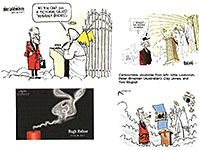
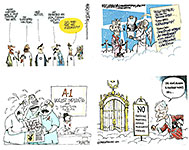

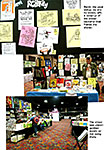
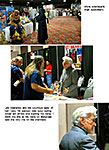
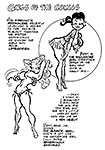

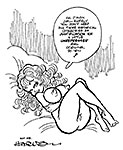
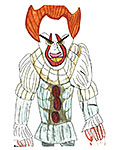
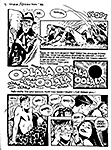

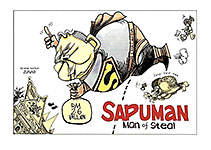
1.jpg)
2.jpg)
3.jpg)
4.jpg)
5.jpg)
6.jpg)
7.jpg)
8.jpg)
9.jpg)
10.jpg)
11.jpg)
12.jpg)
13.jpg)
